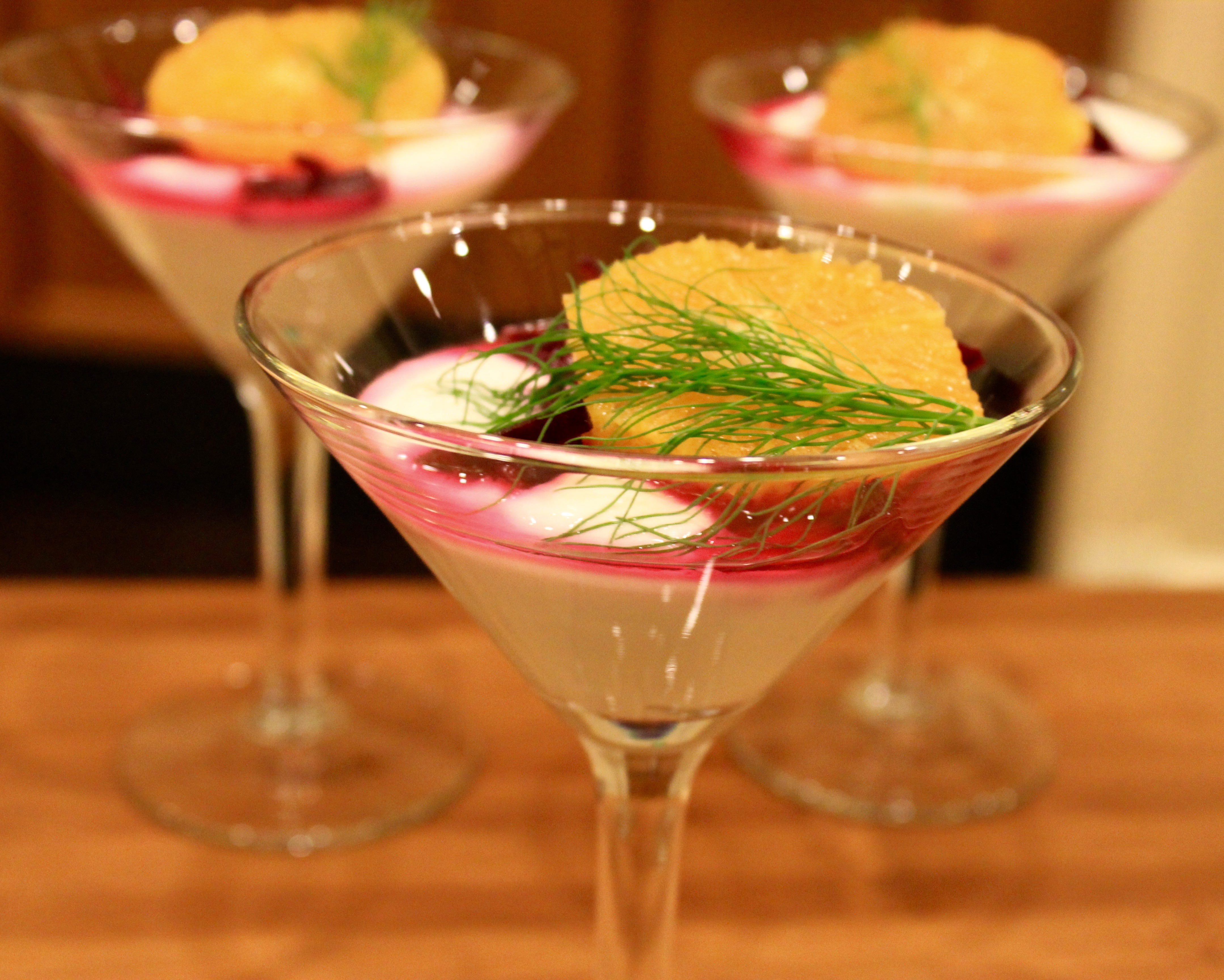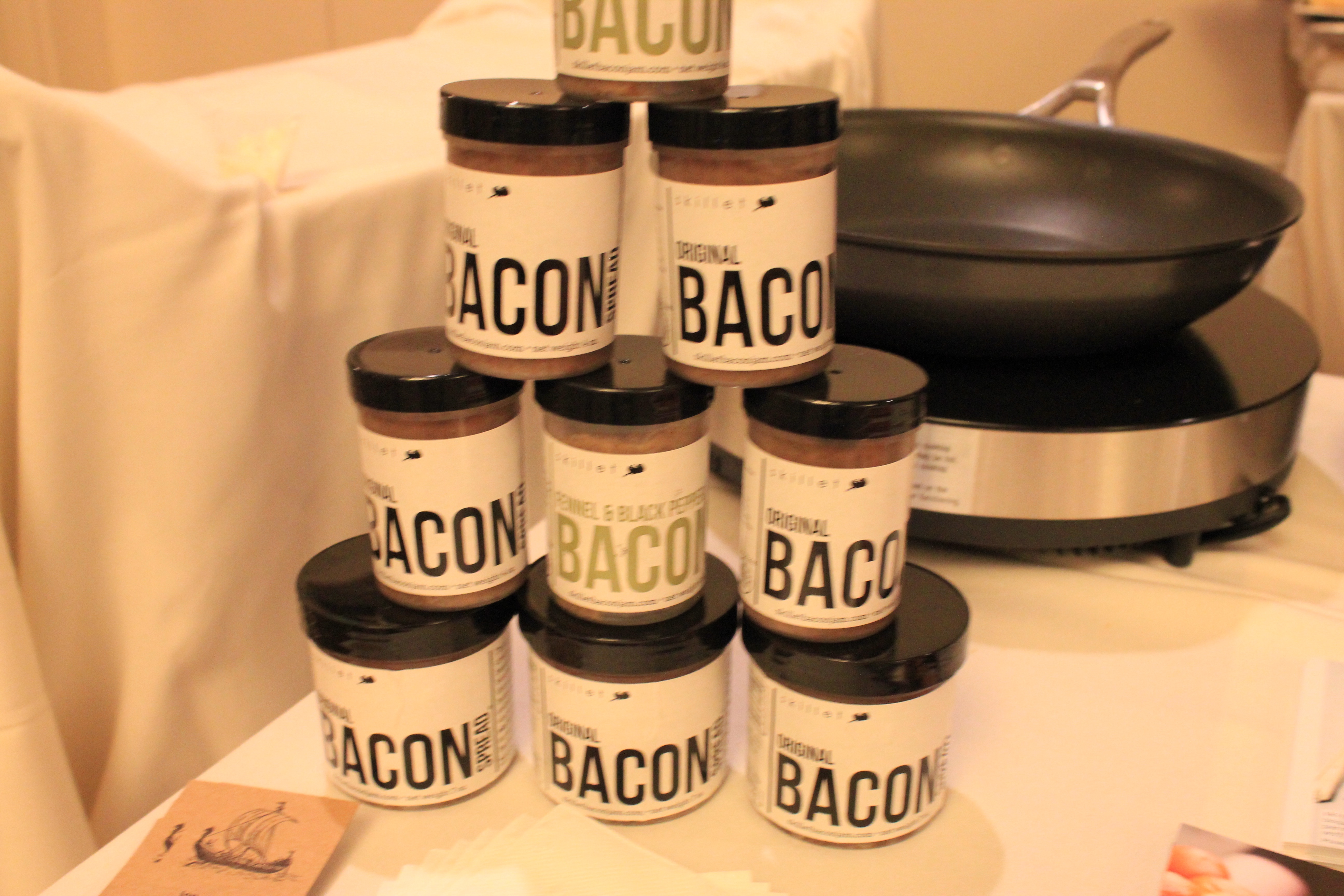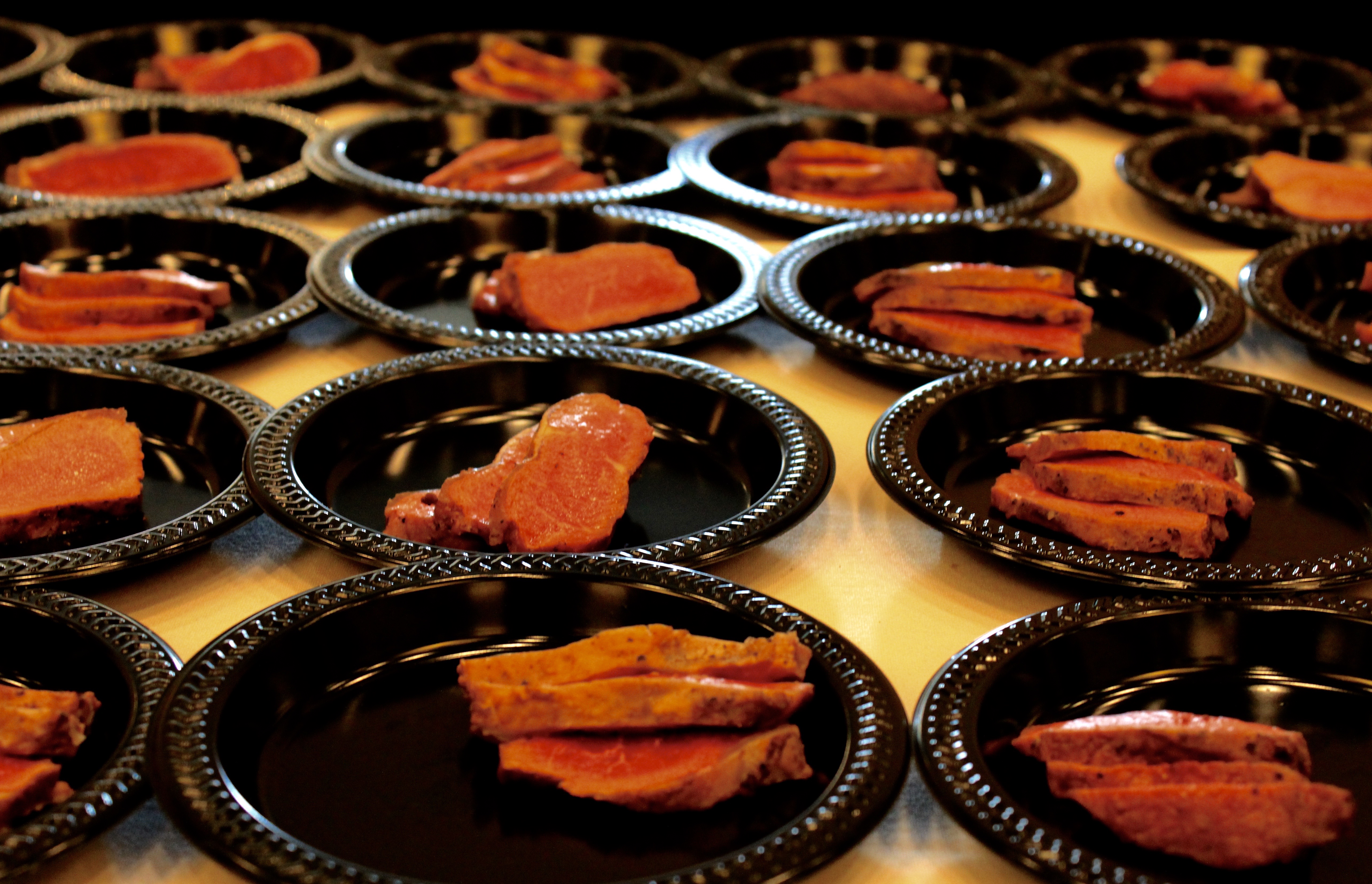Sugar (bah bah bah bah–bah bah), uh, Honey Honey bah bah bah bah — bah bah), you are my Candy Girl, and you got me wanting you.

Breakfast parfait, anyone? The Sensible Celiac asked what was in the parfait, and as suspected, she could not partake because of the yoghurt. Read here how to parse the world of food for the food-sensitive or allergic individual. Yes, even at a food blogger conference.
I couldn’t help singing this song by the Archies under my breath as I walked into the ballroom of the Seattle Sheraton Hotel, where the 2015 International Food Bloggers Conference 2015 was just about to have its morning keynote address. Breakfast had already been laid out, and I timed my arrival at about fifteen minutes before the keynote, so I could take a voyeuristic peek at what was served after I had already breakfasted myself at home. This is my usual practice: to not arrive hungry. It is how I roll.
What is it like to be the self-described “Sensible Celiac” behind MyAllergyAdvocate, a website that will be dedicated to the autoimmune disease and food allergy community, and to enter room after room, food and wine receptions, and special breakout sessions… and not be able to eat? Almost all processed gluten-free food does not work for me, and after countless times of getting sick (from mild GI distress to hospitalization), I am healthy and safe when I limit my eating out ventures to what I can carry with me in a bento box.
How do I do attend a conference like this and enjoy myself, you ask? Well, you find the sweet spot. And then, you bring it home and share it with others.
All Your Fat Are Belong To Me
Years ago, I observed a teenage girl at a luncheon hosted by a Chinese church. The featured main dish was sliced pork with soy sauce and vegetables, and the girl wasted no time in the queue with her paper plate before she had a serving of steamed white rice and two servings of pork and vegetables.
Like many of her friends, she had a willowy body and long black hair. I watched her sashay from adult to adult, plaintively asking, “Can I have your fat? Can I please have your fat if you’re not going to eat it?” Many of the adults had trimmed any excess fat off their pork slices, and they willingly scraped that fat onto her plate. I heard her counting the pieces: “Twenty-eight, twenty-nine, thirty!” And then, deftly wielding a pair of wooden chopsticks, she popped each piece of fat into her mouth, polishing off that rather impressive pile of fat until her plate had nothing on it but the residue of soy sauce!
Why on earth did she do that? How did she know that eating dietary fat does not make you fat, as we once thought it did?
I’ve become a contemporary fat detector, shamelessly asking vendors about the fat source of their food. Got some hummus? What kind of fat are you using? Soy, you say? No, thank you. Oh, I see you have an avocado soup. Are there any other ingredients I should know about? Nope, just avocado? Hurry up and get in my mouth!

Love avocados? There’s a hashtag for that! Finding calories from healthy fat in foods is part of finding your sweet spot for eating.
Finding the sweet spot at the IFBC involves finding your niche target audience. They represent the fat of the land, and in my case, it’s literally the FAT that we’re after! Foods made with healthy fats from nuts, seeds, oils, and animal fats were on my hit list for the conference, and I easily found them. Sure, there were attractive dishes with breads and cookies, and even a gluten free offering or two. Yet if they were not naturally gluten free items and also free of excess refined sugar, these are an automatic “no” for me. Enough “no’s” from the target market means food producers receive your signal that you will not spend your dollars on their product. Enough “yes’s” tells the food producer that you want more of the same. BTW, I had two servings of the cold avocado soup, which was my version of double fisting it, one in each hand. I would have slurped another one if the server would’ve just turned her back for one more moment.
I truly believe that the consumer has an incredible amount of power in his or her dollar to shape the food industry. Case in point, the gluten free Cheerios disaster that emerged this year. On October 5, 2015, General Mills announced a 1.8 million box recall on several of their gluten-free cereals after their products were investigated through individual box testing and found to contain gluten. While I’m not surprised, since I advocate avoiding all foods that are not naturally gluten-free, I also know that as a food consumer in their target market, I had refused to spend a single dollar on their product since its creation. I also told every person I knew in the target market to consider avoiding this product, based on their poor testing process and lack of clarity on how the product was made safe for people with Celiac Disease as well as anyone with a wheat allergy. Again, the clearest way to send a signal to a food producer is how you spend your dollar.
A good amount of my dollars, and thus attention, are spent on calories that come from fat. When I look for recipes, meal plans, and foods for healing, I’m scouring and scanning for the fat! All your fat belongs to me!
In terms of food as medicine, I would be much more sickly and severely underweight without these healthy fats in my diet. Anyone with an autoimmune disease or food allergies should take a serious look at their nutritional plans and talk over with a trusted expert on how they can leverage the healthful benefits of dietary fats in their foods.
If only I could eat cheese! Oh well, I guess I’ll continue to throw coconut oil and flaxseed oil on everything.

My Inner French Girl is always enticed by cheese, but for now, I have to enjoy them through the other senses. Someday, cheese will be mine! During breakout sessions, IFBC participants were treated to samples, contests, and gifts. I won a skillet from Anolon, and was gifted a leg of lamb.
Make Way for The Cereal Killer

Getting around a food blogging conference requires eating food. For me, it also requires a set of bifocals to read ingredient lists. The food allergic person can take in anything through the eyes, just not always through the mouth!
My friend’s tease me and say that I should invent my own comic book character. She would be a woman with a cape and maybe a Zoodle in her hand, and her motto would be, ” Imei, the Gluten Assassin: you’ll never call her Cereal Killer again.” I’m not ashamed. I stopped eating cold, crunchy cereal long before I received my Celiac Disease diagnosis. You just can’t come from that many generations of rice-eating ancestors and joyfully embrace the convenience of pouring your food from a box and drowning it in cow’s milk. I’ll take a bowl of hot rice soup with a side of pickles, fermented cabbage, and leftover meat from last night’s dinner, please! I lost my ability to eat cow’s milk dairy somewhere around college. I suppose “Cereal Killer” may just be a label that sticks, and a milk allergy basically solidifies my quest for other breakfast foods in the morning.
Eventually, I came to see that if I stay on the “Food as Medicine” track, even the rice soup disappeared from my weekly breakfast menu. Why? While it is easily digestible, it’s still a grain. For about thirty days, my body needed to be completely off all grains before it could “reset” and heal. Those few weeks I was off all grains would have been easy if it hadn’t been for removing rice, but it did help. Why? I suspect that it wasn’t so much that I had any reaction to rice itself, but rather my body was healing in the absence of so much carbohydrate.
I became a “Cereal Killer” as I removed excess sugar from my lifestyle. That simple and profound change turned my body into a fat burner. Instead of downing Honey Stingers, I woofed slivers of bacon before triathlon races. With access to the 70,000-80,000 calories of fat available to it at any given time, I stopped feeling so fatigued and hungry. It has transformed my triathlon and running races from expected time in the Honey Bucket to restful naps with the cat after a job well done.
At IFBC, keeping to a low-carbohydrate, high fat lifestyle is about as difficult as being vegetarian and attending the Curriculamb breakout session. How can you not partake, right? Well, the vendors make it pretty easy for me. If an item has gluten in it, then automatically it’s a “no”. There is no cheating, because cheating is equated to a long night in the hospital and days of fatigue, dizziness, brain fog, anemia, malabsorption, and severe weight loss. That’s not my idea of a party.
So I decided that I would imbibe my sugar instead! Yes, you guessed it: wine.

Green chartreuse imported just for a special drink? I said, yes! And then a commitment to detox the system of sugar must follow. alcoholic drinks that are not made of wheat, rye, or barley are gluten free. The deal was this: drink one night, and then detox the system for at least three days. The wine reception Saturday evening allowed the Sensible Celiac to indulge in sugar. I cannot say I felt in the least bit deprived.
It would be totally irresponsible for me to fail to mention that anyone who needs to take care of Candida overgrowth issues is not going to be able to drink alcohol. No, not even a little. Fortunately for me, that’s not something I’m presently dealing with.
And so, I had my indulgence. Think of it as my gluten-free dessert. The cost? A mild headache at the end of the night, the need to drink enough water that I had to get up in the middle of the night to do the Bathroom Shuffle (twice!), and the usual regrets the next morning. I honestly had not indulged in that way for quite some time, but I had the opportunity to try some fine wine pours, sparkling wines, and check out the Coravin Wine System, which I thought was a clever way to access a bottle of wine while preserving freshness.
[youtube https://www.youtube.com/watch?v=yP-kuf5zVQw]
Finding the sweet spot, whether in food blogging or in daily eating, is about going beyond gluten free and high sugar foods. It’s finding truly healthy foods that heal. And when I can’t find them, then I consider savvy substitutions, or rebuild a food concept from the foundation up until it suits my standards and taste.
I gain ideas by taking them in through my eyes. Simple, high quality, meaningful, and socially attractive foods — that is, food magnets that draw people in — can be made at home. Yes, it is completely possible to make a flourless chocolate cake that even your gluten-eating friends want to steal off your dish. I just found that by attending the IFBC, my creative mind could scamper happily from one idea to the next.
What IFBC did for me was to help strengthen my resolve in the communication of these ideas to others. I realized I’m not going to be only a resource for recipes for the autoimmune community. What I really am is a Citizen Journalist who will be relied upon to give truthful descriptions and real experiences about nourishing people — that deep feeding that we all truly need — that goes beyond looking at micro and macronutrient information on the side of package. What my community wants to know is how we can truly feed ourselves, connect with others, and celebrate life with gatherings at the same table, and be both healthy and satiated, connected and bonded.
It’s sitting in my Task Box of my online project management tool to write a post about the Psychology of the Table. This subject is something I’ve been wanting to write perhaps all my life. Yet it took attending the IFBC, not with shame and timidity because I can’t eat all the same foods, but because I met people like myself who are coming to the table with who they are, that convinced me that I have a future in educating and writing about food in a way that brings all of us back to the table.
I found my sweet spot. Here’s to helping you find yours.





